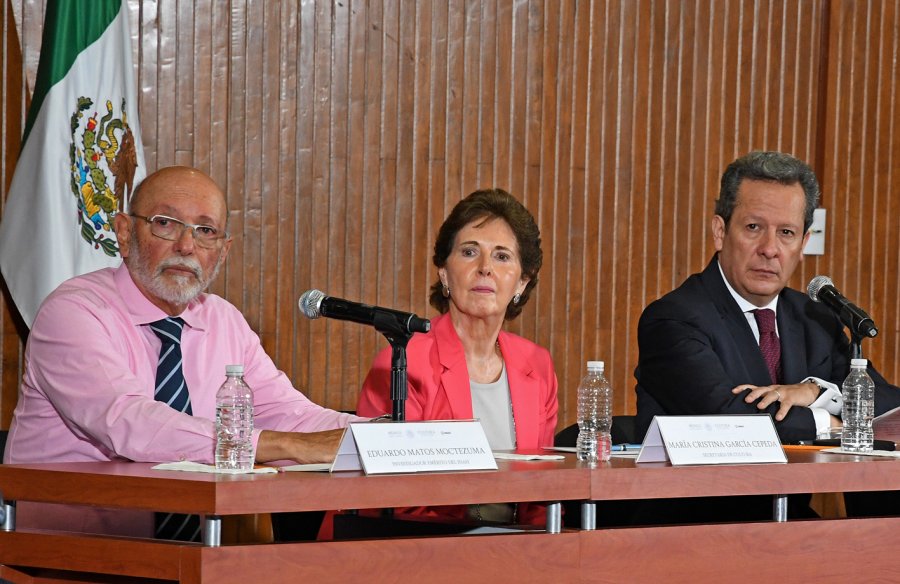Noticias
Discovery of archaeological remains of the Temple of Ehécatl and the Ball Game of Mexico-Tenochtitlan
June 07, 2017After seven years of constant work on a place located behind the Metropolitan Cathedral, the remains of the main Temple of Ehécatl (Mexican god of the wind), as well as a corner of the Ball Game of ancient Tenochtitlan have been discovered in the Historic Center of Mexico City.
The announcement was made by Eduardo Sánchez, spokesman for the Presidency of the Republic, accompanied by the Secretary of Culture, Maria Cristina García Cepeda; Diego Prieto, general director of the National Institute of Anthropology and History; archaeologist Eduardo Matos Moctezuma and Raúl Barrera, coordinator of the Urban Archeology Program (PAU, for its acronym in Spanish).
Eduardo Sánchez said that the discovery of the Temple dedicated to the god Ehécatl enriches the heritage of Mexicans and ratified that the administration of President Enrique Peña Nieto will continue to support the programs to protect and spread over 20,000 monuments and 40,000 archaeological sites that exist in the country.
María Cristina García Cepeda said that these findings are in addition to the great discoveries that for almost 40 years - after the discovery of the monolith of Coyolxauhqui- have brought Mexican society of today "to the splendor of the pre-Hispanic city of Tenochtitlan".
This is due to the work of INAH researchers "and to their commitment to safeguard the archaeological heritage of our country," the secretary acknowledged at the media meeting held at the Templo Mayor Museum.
Anthropologist Diego Prieto Hernández stressed that the discoveries of both Mexican buildings that constitute sections of the Temple of Ehécatl and the Ball Game are not the result of a fortuitous event, but the result of a constituted project 25 years ago: the Urban Archeology Program (PAU, for its acronym in Spanish), which recovers the vestiges of what was the Ceremonial Site of Mexico-Tenochtitlan that lie under the subsoil of seven blocks of the Historical Center of the capital of the country.
"Time, resources and knowledge required by archaeological work are factors that only an institution like INAH has been able to solve, under conditions that were not always ideal”. The current context, he said, requires strengthening work in the interior, but also expanding relations with other institutions, civil society groups and individuals”.
From these alliances come discoveries such as the present ones, allowing to determine locations, orientations and dimensions of the structures that make up the sacred space of the Mexica culture, being the most accurate approach the Architect Ignacio Marquina’s mockup, who took references from the time of contact with the Spanish and the Colony.
In that sense, Professor Eduardo Matos Moctezuma, researcher emeritus of the INAH and founder of the Project Templo Mayor and the PAU, explained to the audience that the Temple of Ehécatl, divinity that with its benign winds attracted rain, was located in front of the altar of Tláloc, fecund deity that lived in the Templo Mayor next to the warrior god Huitzilopochtli; and assured that the findings that have been made, allow a broader concept of the Mexica culture.
The Urban Archeology Program team found a rectangular structure from 34 to 36 meters length, which has two circular bodies attached to the back, the largest one with a diameter of approximately 18 meters and separated by a walkway of 1.10 meters.
During the works in the area Guatemala 16 -Professor Matos Moctezuma said -, the PAU also discovered a nine-meter wide platform bounded by the western head of the Ball Court. In this space, which was aligned with the altar of Huitzilopochtli, were detected the remains of a stairway where the fighters had to enter the ritual court.
It was under the floor of a stairway that limits to the north the Ball Game, where the archaeologists of the INAH located the only ritual offering found in the excavations in the place. The population was made up of several groups of human cervicals still holding its anatomical position, corresponding to about thirty individuals whose ages ranged from infants (0-6 years) to young people.
Archaeologist Raúl Barrera, responsible for the PAU, explained that according to the evidence of three constructive stages detected until now, both buildings were in use at least since 1481 (during the Tizoc government) and subsequent Ahuízotl and Moctezuma Xocoyotzin governments, until 1519, coinciding with the arrival of the Spaniards. Once the conquest was completed, the Tenochca buildings were gradually dismantled in their higher stages to build the viceregal capital.
During the media tour of Guatemala 16, Raúl Barrera noticed the quality of the floor of slates that dates from period VI (about 1486 A.D.), as well as the enormous curvature of the base of the temple made of tezontle joined with mud which conserves much of its original flattened.
The knowledge and preservation of the Temple of Ehécatl and the Ball Game is the result of the collaboration of several professionals, who have been committed to its rescue in various seasons of work in the last seven years: archaeologists Ivan Urdapilleta, Israel Fuentes, Lorena Vázquez, Ingrid Trejo, Sandra Liliana Ramírez, Moramay Estrada, José María García, Eduardo Ambrosio Lima, Miguel Guadarrama and Mariel de Lourdes Mera Cáceres; as well as restorers Federica Grifi and Patricia Campos Díaz.
Mexico,Distrito Federal
